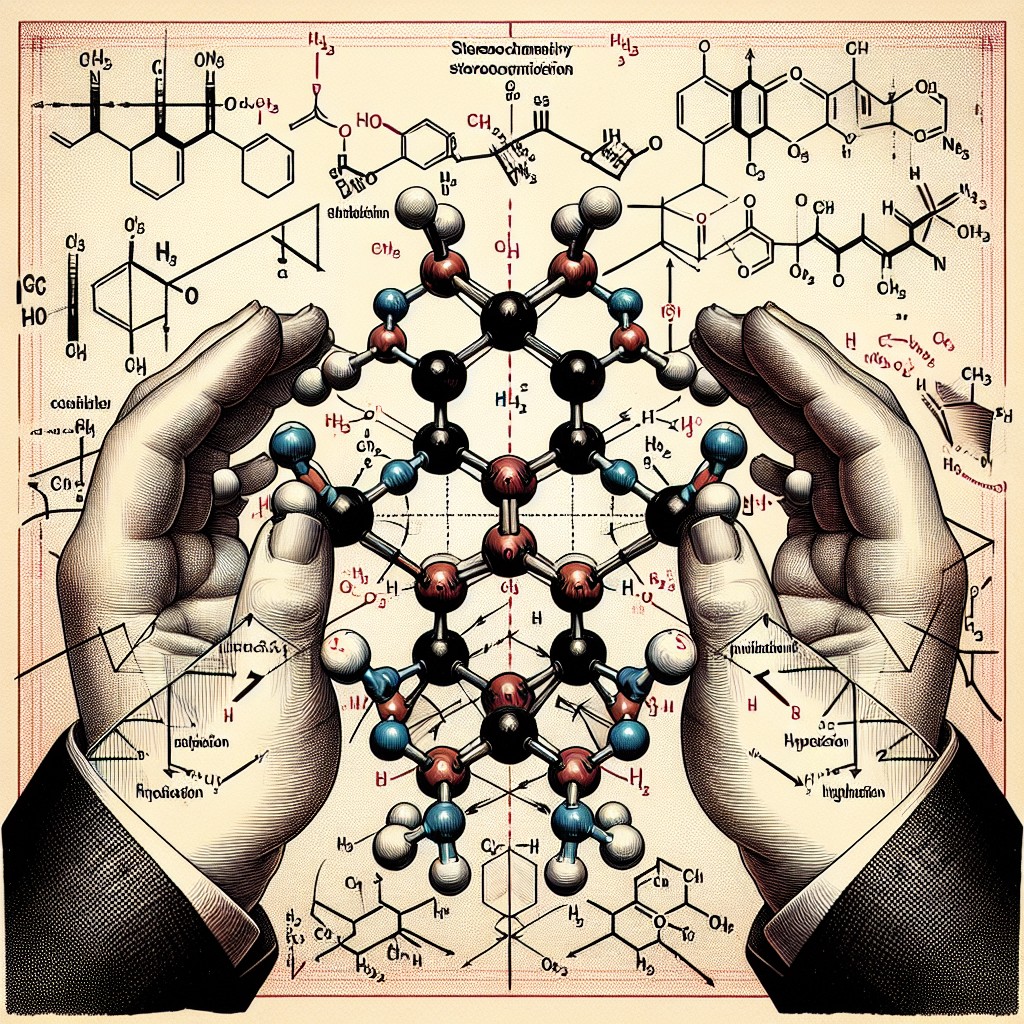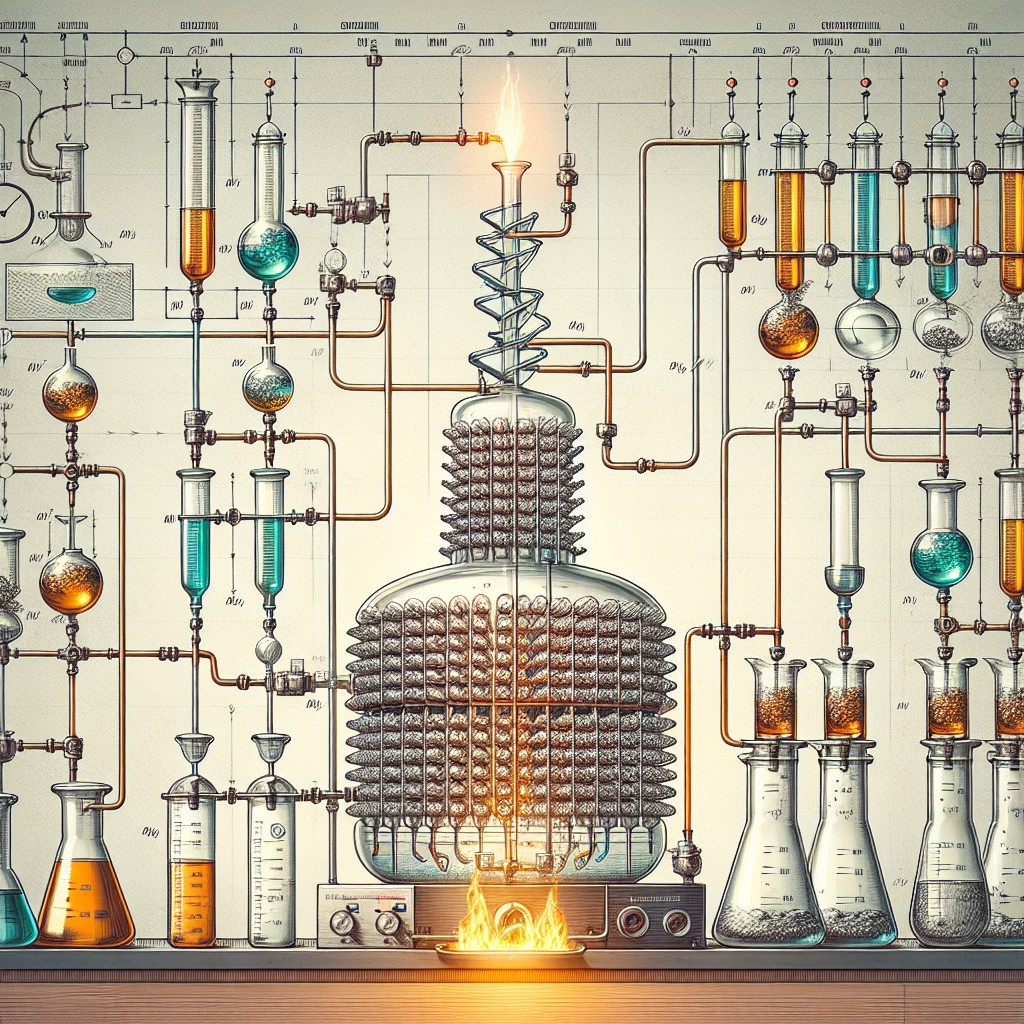
Stereochemistry is a branch of chemistry that deals with the three-dimensional arrangement of atoms in molecules and the effect of this arrangement on the chemical and physical properties of compounds. It focuses on the study of molecular symmetry, which refers to the arrangement of atoms in space and the resulting symmetry or asymmetry of a molecule.
The importance of molecular symmetry in stereochemistry cannot be overstated. The arrangement of atoms in a molecule determines its shape, which in turn affects its reactivity, biological activity, and physical properties. Understanding molecular symmetry is crucial for predicting how molecules will interact with each other and how they will behave in various chemical reactions.
Summary
- Understanding molecular symmetry is crucial in stereochemistry.
- Stereochemistry plays a vital role in both chemistry and biology.
- Asymmetric molecules have chirality, which is important in stereochemistry.
- Enantiomers and diastereomers are types of stereoisomers.
- Stereochemistry is essential in drug design and development.
The Importance of Stereochemistry in Chemistry and Biology
Stereochemistry plays a vital role in both chemistry and biology. In chemistry, stereochemistry is essential for understanding the behavior of molecules in reactions and for designing new compounds with specific properties. For example, the stereochemistry of a drug molecule can determine its effectiveness and safety. In biology, stereochemistry is crucial for understanding the structure and function of biomolecules such as proteins and enzymes.
One example of stereochemistry in chemistry is the concept of chirality. Chirality refers to the property of a molecule that cannot be superimposed on its mirror image. Chiral molecules have two non-superimposable mirror image forms called enantiomers. This property has significant implications in drug design and development, as enantiomers can have different biological activities and pharmacokinetic properties.
In biology, stereochemistry is essential for understanding the structure and function of biomolecules. For example, proteins are made up of amino acids, which are chiral molecules. The specific arrangement of amino acids in a protein determines its three-dimensional structure, which is crucial for its function. Understanding the stereochemistry of proteins is essential for studying their interactions with other molecules and developing drugs that target specific protein structures.
Chirality: The Basics of Asymmetric Molecules
Chirality is a fundamental concept in stereochemistry. It refers to the property of a molecule that cannot be superimposed on its mirror image. Chiral molecules exist in two non-superimposable mirror image forms called enantiomers. Enantiomers have the same chemical and physical properties, except for their interaction with other chiral molecules, such as enzymes or receptors.
Chiral molecules have several important properties. First, they rotate plane-polarized light, a phenomenon known as optical activity. This property can be used to determine the presence of chiral molecules in a sample and to quantify their concentration. Second, chiral molecules can exhibit different biological activities and pharmacokinetic properties. For example, one enantiomer of a drug molecule may be therapeutically active, while the other enantiomer may be inactive or even toxic.
There are many examples of chiral molecules in nature and in synthetic compounds. Some common examples include sugars such as glucose and fructose, amino acids such as alanine and valine, and natural products such as morphine and penicillin. Chirality is also found in many synthetic drugs, where it can have a significant impact on their efficacy and safety.
Enantiomers and Diastereomers: Types of Stereoisomers
| Stereoisomer Type | Definition | Examples |
|---|---|---|
| Enantiomers | Non-superimposable mirror images of each other | L-alanine and D-alanine |
| Diastereomers | Stereoisomers that are not mirror images of each other | Cis-trans isomers of alkenes |
Stereoisomers are compounds that have the same molecular formula and connectivity of atoms but differ in their three-dimensional arrangement in space. There are two main types of stereoisomers: enantiomers and diastereomers.
Enantiomers are mirror image forms of each other and cannot be superimposed on each other. They have the same physical and chemical properties, except for their interaction with other chiral molecules. Enantiomers rotate plane-polarized light in equal but opposite directions, a property known as optical rotation.
Diastereomers, on the other hand, are stereoisomers that are not mirror images of each other. They have different physical and chemical properties and can have different biological activities. Diastereomers do not rotate plane-polarized light in equal but opposite directions.
An example of enantiomers is the drug molecule ibuprofen. Ibuprofen exists as a racemic mixture of two enantiomers, (R)-ibuprofen and (S)-ibuprofen. The (S)-enantiomer is responsible for the analgesic and anti-inflammatory activity of ibuprofen, while the (R)-enantiomer is inactive. Separating the enantiomers of ibuprofen can lead to more effective and safer drugs.
An example of diastereomers is the drug molecule thalidomide. Thalidomide was originally marketed as a sedative and anti-nausea medication but was later found to cause severe birth defects. It was discovered that thalidomide exists as a mixture of two diastereomers, (R)-thalidomide and (S)-thalidomide. The (S)-diastereomer is responsible for the sedative effects of thalidomide, while the (R)-diastereomer is responsible for its teratogenic effects.
The Role of Stereochemistry in Drug Design and Development
Stereochemistry plays a crucial role in drug design and development. The stereochemistry of a drug molecule can determine its biological activity, pharmacokinetics, and safety profile. Enantiomers, in particular, can have different pharmacological properties, making them important targets for drug development.
The importance of stereochemistry in drug design is exemplified by the case of the drug molecule omeprazole. Omeprazole is a proton pump inhibitor used to treat gastric acid-related disorders such as peptic ulcers and gastroesophageal reflux disease. Omeprazole exists as a racemic mixture of two enantiomers, (S)-omeprazole and (R)-omeprazole. It was found that the (S)-enantiomer is responsible for the therapeutic activity of omeprazole, while the (R)-enantiomer is inactive. Separating the enantiomers of omeprazole led to the development of esomeprazole, a more potent and selective drug.
Developing stereoisomeric drugs can be challenging due to the need to separate and purify the enantiomers and to ensure their stability and bioavailability. In addition, the pharmacokinetics of enantiomers can differ, leading to differences in their absorption, distribution, metabolism, and excretion. These challenges require careful consideration of stereochemistry in drug design and development.
Stereochemistry in Organic Synthesis: Strategies and Techniques
Stereochemistry plays a crucial role in organic synthesis, the process of creating new organic compounds from simpler starting materials. Controlling stereochemistry in organic synthesis is essential for obtaining specific stereoisomers with desired properties.
There are several methods for controlling stereochemistry in organic synthesis. One common strategy is to use chiral reagents or catalysts that can selectively induce the formation of a specific stereoisomer. For example, chiral auxiliaries can be used to control the stereochemistry of a reaction by temporarily attaching a chiral group to a molecule.
Another strategy is to use stereoselective reactions, which are reactions that preferentially form one stereoisomer over another. Stereoselective reactions can be achieved through various mechanisms, such as steric effects, electronic effects, or through the use of chiral catalysts.
The importance of stereochemistry in organic synthesis is exemplified by the synthesis of natural products. Many natural products have complex structures and exhibit unique biological activities. The stereochemistry of natural products is often crucial for their biological activity, making stereocontrolled synthesis essential for obtaining biologically active compounds.
Spectroscopic Methods for Studying Stereochemistry
Spectroscopic methods are powerful tools for studying stereochemistry. Spectroscopy involves the interaction of electromagnetic radiation with matter and the measurement of the resulting signals. Several spectroscopic techniques can be used to determine the stereochemistry of a compound.
One example is nuclear magnetic resonance (NMR) spectroscopy, which can provide information about the three-dimensional arrangement of atoms in a molecule. NMR spectroscopy can be used to determine the relative configuration of stereocenters and to identify the presence of chiral molecules in a sample.
Another example is infrared (IR) spectroscopy, which can provide information about the functional groups present in a molecule. IR spectroscopy can be used to determine the presence of chiral functional groups and to study their interactions with other molecules.
Other spectroscopic techniques, such as circular dichroism (CD) spectroscopy and vibrational circular dichroism (VCD) spectroscopy, can also be used to study stereochemistry. CD and VCD spectroscopy measure the differential absorption of left- and right-circularly polarized light by chiral molecules, providing information about their three-dimensional structure.
While spectroscopic methods are powerful tools for studying stereochemistry, they have limitations. For example, NMR spectroscopy can provide information about the relative configuration of stereocenters but cannot determine their absolute configuration. In addition, spectroscopic methods may not be applicable to all compounds or may require specialized equipment and expertise.
Stereoselective Reactions: Controlling Stereochemistry in Chemical Reactions
Stereoselective reactions are chemical reactions that preferentially form one stereoisomer over another. Controlling stereochemistry in chemical reactions is essential for obtaining specific stereoisomers with desired properties.
There are several factors that can influence the stereochemistry of a reaction. One factor is steric effects, which arise from the repulsion between atoms or groups in a molecule. Steric effects can influence the orientation of reactants and the geometry of transition states, leading to the formation of specific stereoisomers.
Another factor is electronic effects, which arise from the distribution of electrons in a molecule. Electronic effects can influence the reactivity of molecules and the stability of intermediates, leading to the formation of specific stereoisomers.
Chiral catalysts are another important tool for controlling stereochemistry in chemical reactions. Chiral catalysts are catalysts that have a chiral structure and can selectively induce the formation of a specific stereoisomer. Chiral catalysts can be used in various types of reactions, such as asymmetric hydrogenation, asymmetric aldol reactions, and asymmetric epoxidation.
Stereoselective reactions are important in chemical synthesis because they allow for the selective formation of specific stereoisomers. This is particularly important in drug synthesis, where the stereochemistry of a drug molecule can determine its biological activity and pharmacokinetics.
The Fascinating World of Supramolecular Stereochemistry
Supramolecular stereochemistry is a branch of stereochemistry that deals with the three-dimensional arrangement of molecules in supramolecular assemblies. Supramolecular assemblies are structures formed by the non-covalent interactions between molecules, such as hydrogen bonding, van der Waals forces, and π-π interactions.
Supramolecular stereochemistry explores how the three-dimensional arrangement of molecules in supramolecular assemblies affects their properties and behavior. For example, the arrangement of molecules in a supramolecular assembly can determine its stability, solubility, and reactivity.
One example of supramolecular stereochemistry is the phenomenon of molecular recognition. Molecular recognition refers to the selective binding of one molecule by another through non-covalent interactions. The three-dimensional arrangement of molecules in a supramolecular assembly can determine the specificity and strength of molecular recognition.
Supramolecular stereochemistry has many applications in areas such as materials science, catalysis, and drug delivery. For example, supramolecular assemblies can be used as templates for the synthesis of nanomaterials with specific shapes and properties. They can also be used as catalysts for various chemical reactions or as carriers for drug molecules.
Future Directions in Stereochemistry: Emerging Trends and Applications
Stereochemistry is a rapidly evolving field with many emerging trends and applications. One emerging trend is the development of new methods for controlling stereochemistry in chemical reactions. Researchers are exploring new catalysts, reaction conditions, and strategies for achieving high levels of stereoselectivity.
Another emerging trend is the application of stereochemistry in materials science and nanotechnology. Researchers are using stereochemistry to design and synthesize new materials with specific properties, such as optical activity, chirality, and self-assembly.
In addition, stereochemistry is finding new applications in areas such as drug delivery, gene therapy, and molecular imaging. Researchers are exploring how the three-dimensional arrangement of molecules can affect their interactions with biological systems and how this knowledge can be used to develop new therapies and diagnostic tools.
The future of stereochemistry research lies in the integration of different disciplines and the development of new techniques and approaches. By combining the principles of stereochemistry with other fields such as computational chemistry, biochemistry, and materials science, researchers can gain a deeper understanding of molecular symmetry and its impact on chemical and biological systems.
Stereochemistry is a fascinating field that plays a crucial role in chemistry and biology. Understanding the three-dimensional arrangement of atoms in molecules is essential for predicting their behavior in reactions, designing new compounds with specific properties, and understanding the structure and function of biomolecules.
Chirality is a fundamental concept in stereochemistry, and chiral molecules have unique properties and can exhibit different biological activities. Enantiomers and diastereomers are two types of stereoisomers that have different physical and chemical properties. The stereochemistry of a drug molecule can determine its biological activity, pharmacokinetics, and safety profile.
Controlling stereochemistry in chemical reactions is essential for obtaining specific stereoisomers with desired properties. Spectroscopic methods are powerful tools for studying stereochemistry, but they have limitations. Supramolecular stereochemistry explores the three-dimensional arrangement of molecules in supramolecular assemblies and has many applications in materials science and nanotechnology.
The future of stereochemistry lies in the integration of different disciplines and the development of new techniques and approaches. By further exploring the principles of stereochemistry, researchers can continue to make significant advancements in various fields and contribute to the development of new drugs, materials, and technologies.
FAQs
What is Stereochemistry?
Stereochemistry is the study of the three-dimensional arrangement of atoms in molecules and how this affects their chemical and physical properties.
What is a stereoisomer?
A stereoisomer is a molecule that has the same molecular formula and connectivity as another molecule, but a different arrangement of atoms in space.
What is the difference between enantiomers and diastereomers?
Enantiomers are stereoisomers that are non-superimposable mirror images of each other, while diastereomers are stereoisomers that are not mirror images of each other.
What is chirality?
Chirality is a property of a molecule that describes its non-superimposable mirror image relationship with another molecule. A molecule is chiral if it cannot be superimposed on its mirror image.
What is a chiral center?
A chiral center is an atom in a molecule that is bonded to four different groups, making it a stereocenter and giving the molecule chirality.
What is a racemic mixture?
A racemic mixture is a mixture of equal amounts of two enantiomers. It has no net optical activity and is optically inactive.
What is optical activity?
Optical activity is the ability of a substance to rotate the plane of polarized light. It is a property of chiral molecules and is used to determine the presence of enantiomers in a sample.
What is a meso compound?
A meso compound is a molecule that contains chiral centers but is achiral overall due to its internal symmetry. It has a plane of symmetry that divides the molecule into two identical halves.



